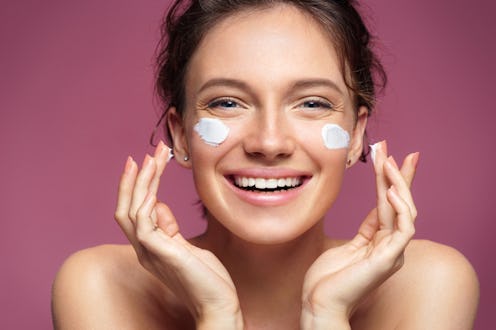
If you've heard a piece of skin care advice once, you've heard it a thousand times. It's the same old, same old: Wash off your makeup before bed! Wear sunscreen every day! (And then reapply it!) Be wise, moisturize! It all seems pretty simple and straightforward. But with the rise of ten-step skin care routines and brand new formulas, things have kind of gotten a little... complicated. And when things get complicated, you're more likely to skip certain steps like, oh, say removing all your makeup at night.
If you're totally flummoxed by skin care routines, don't worry. All you need to know is that hyaluronic acid — a molecule that can hold up to 1,000 times its weight in water — is a key ingredient to any routine. From there, it's just about learning to proper order of layering your products. Don't know when to use your eye cream? No problem. Which comes first, moisturizer or sunscreen? We've got you. That's because we've teamed up with Cetaphil to share exactly how and when to incorporate essential skin care products into your beauty routine. In fact, we went to a pro — Dr. Michele Farber, a dermatologist at Schweiger Dermatology Group in New York City — to find out the details. Trust us: Your skin will never look better.
Start With Cleansing
Even the most powerful skin care products won't do squat if you have a layer of makeup sitting on your skin. Plus, in addition to cleansing, a good face wash can also help balance your skin. "Depending on whether you are more dry, oily, or acne-prone, choose a hydrating cleanser or gently exfoliating cleanser based on your skin needs," says Farber. Those with dry or sensitive skin will benefit from a milky, non-foaming cleanser, while oily and acne-prone types can go for those with gentle exfoliants, like salicylic acid.
Next Up: Serum
Kick things off with the most liquid-y (aka least viscous) formulas before you work your way up to thicker, richer products. Serums usually fall into the former category. "An antioxidant serum, like a vitamin C serum, can be great for protecting against free radical damage and evening out pigment," says Farber. Translation: It boosts the protective power of your SPF and brightens skin.
Add Eye Cream
Your eye cream comes before you moisturize, both a.m. and p.m. Use your ring finger to tap it in. This keeps your touch gentle and helps prevent pulling or tugging, which is extremely important, since "the skin around the eye area is extremely thin," explains Farber. Start at the inner corners of your eyes and work your way outwards. Farber's a fan of anything that contains super hydrating ingredients like hyaluronic acid (which protects and plumps the area) and antioxidants (to help with dark circles). Cetaphil Hydrating Eye Gel-Cream offers both while feeling lightweight and refreshing.
Now, Moisturize
Moisturizer is a non-negotiable, especially in the cooler months. And while having SPF is a perk, there's no question that a good moisturizer should contain deeply hydrating ingredients like hyaluronic acid. Also, "make sure your moisturizer is noncomedogenic," says Farber. (Noncomedogenic, for the uninitiated, means it won't clog pores.) Try Cetaphil Daily Hydrating Lotion, which packs hyaluronic acid and is both noncomedogenic and fragrance-free — meaning it's safe even if your skin is sensitive.
Swap In A Night Cream
At night, use a different moisturizer. It's worth it. "Nighttime creams are often thicker and more hydrating, as they do not need to go under makeup and can promote regeneration," explains Farber. Look for "ingredients to restore your skin barrier and make your skin look younger, including hyaluronic acid, glycerin, and dimethicone," she adds. You can find all of the above in Cetaphil Rich Hydrating Night Cream. Just like your daytime moisturizer should be, it's also noncomedogenic and fragrance-free, so it's perfect for any and all skin types.
Finish With SPF
Now is the time to add your SPF. "Moisturize first, then use your sunscreen," says Farber. "Your SPF should be 30 or above with UVA/UVB coverage." Once it's blended in, you're ready to add foundation. But with a skin routine this good, you might not even need it.
This post is sponsored by Cetaphil.
Design: Mary Blount